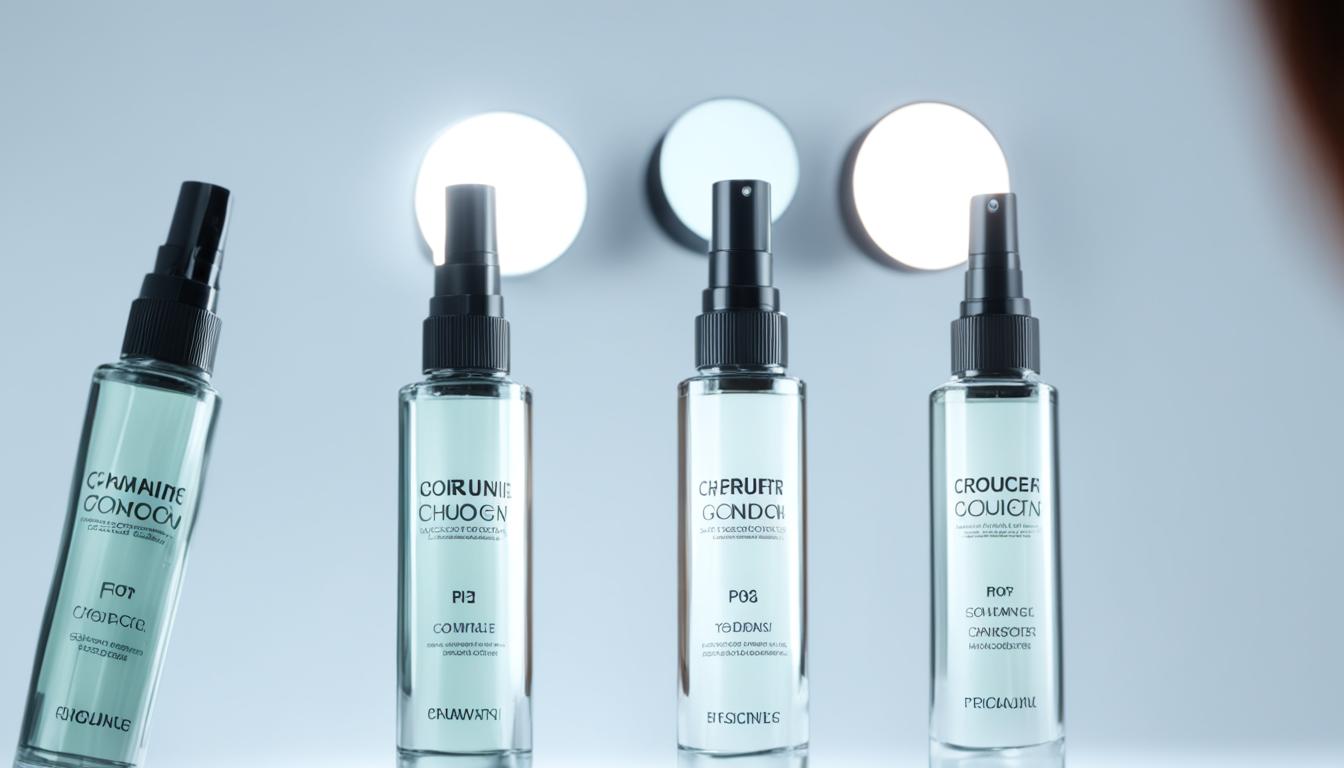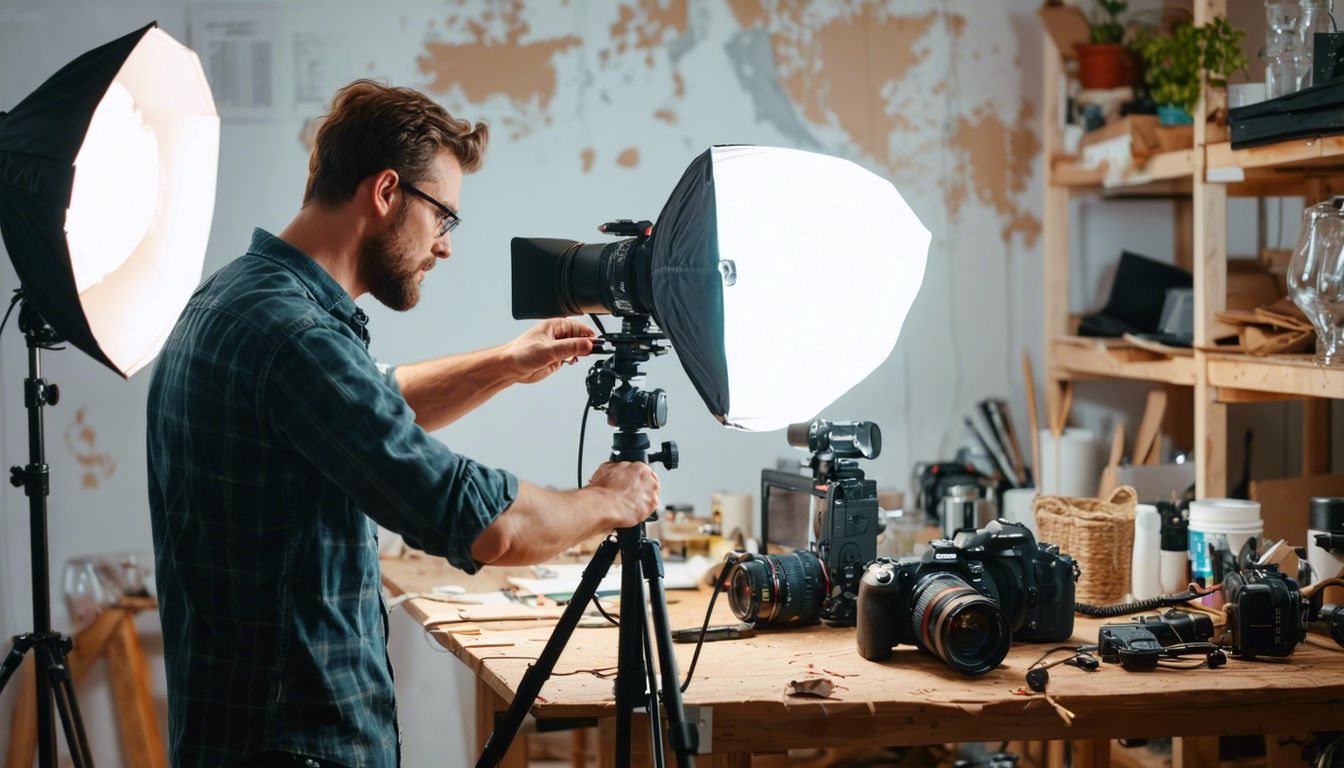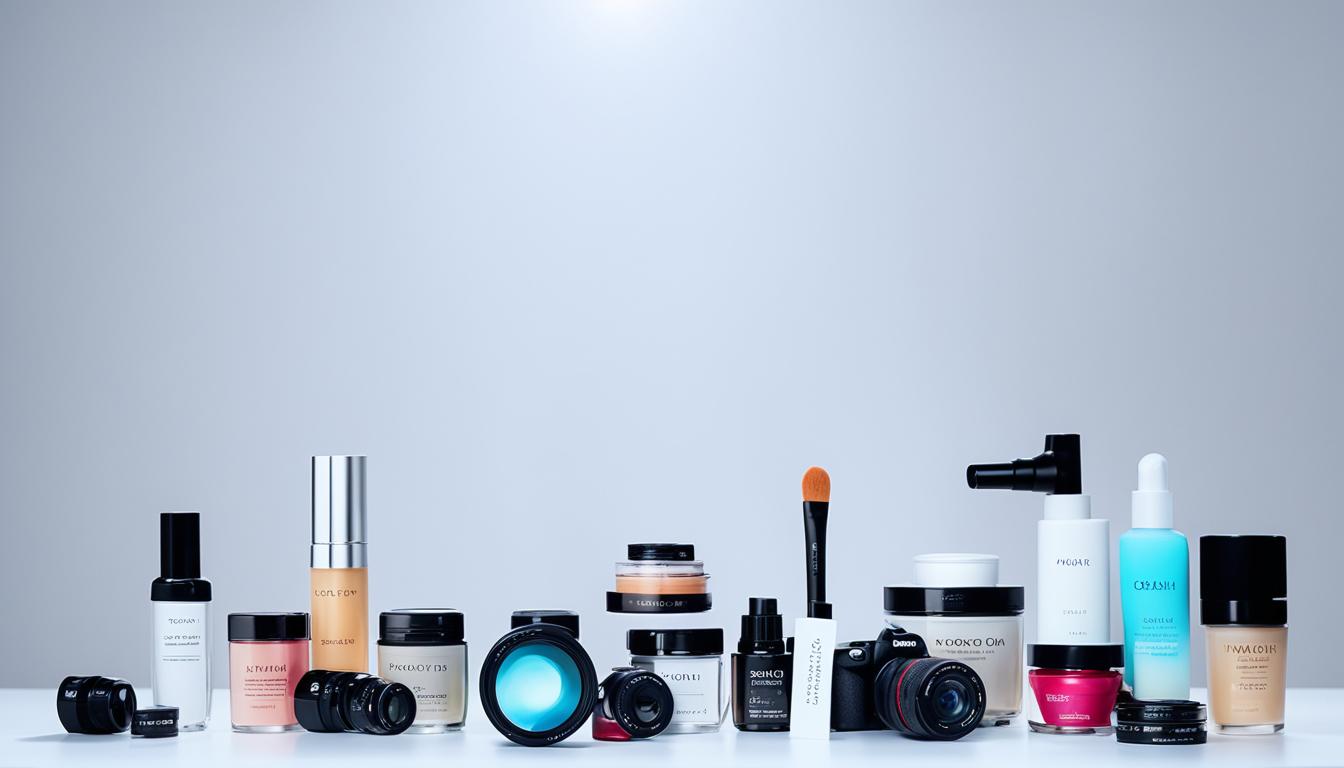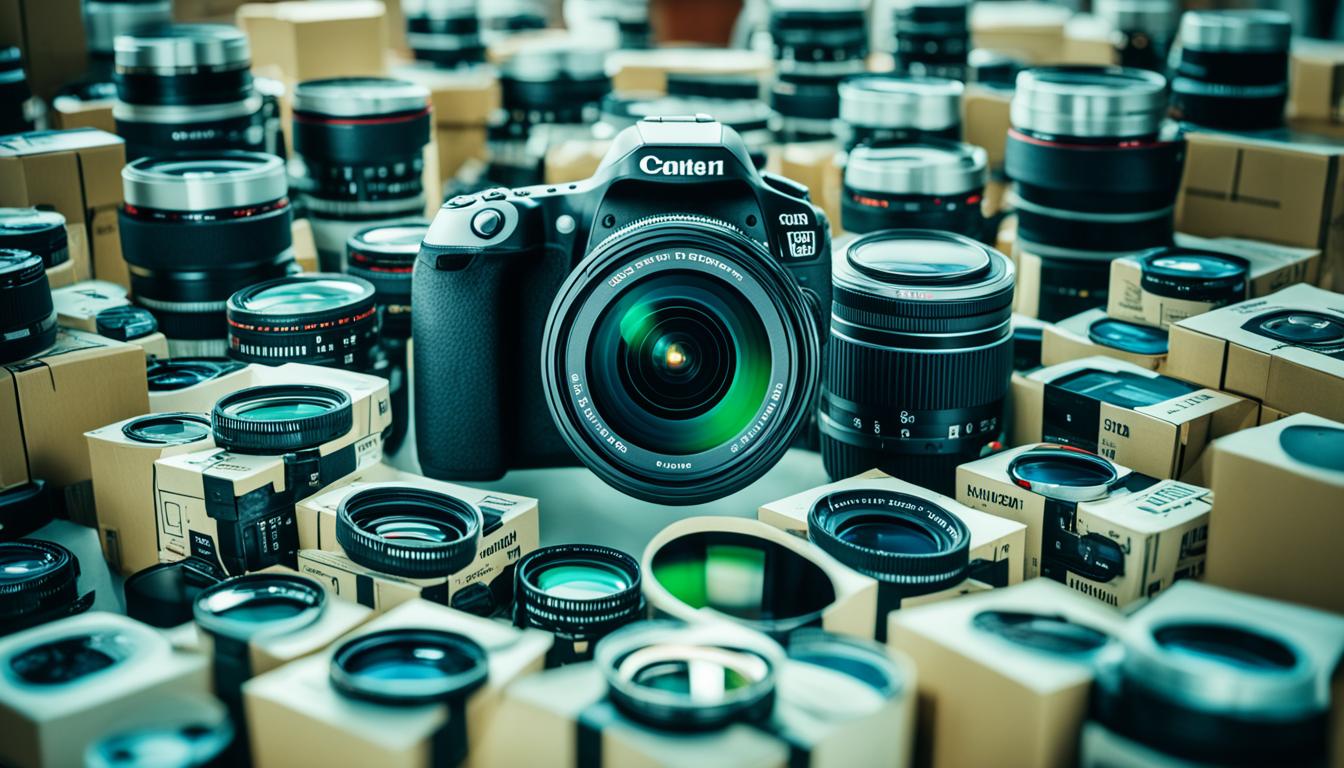In the fast-paced world of e-commerce, high-quality product photography is essential for driving sales. We all know that first impressions matter, especially in the online marketplace. When potential customers are browsing through countless product listings, it’s the quality of your images that will catch their eye and convince them to make a purchase. To boost your product appeal and sales, it’s time to step up your game with advanced product photography techniques.
Key Takeaways
- Investing in professional product photography can significantly impact your sales.
- Setting up a dedicated product photography studio with essential equipment is crucial.
- Understanding and mastering lighting techniques can enhance the visual appeal of your product images.
- Composition and styling play a significant role in creating stunning product photos.
- Post-production editing and retouching can bring your product images to life.
Setting Up a Product Photography Studio
Creating a dedicated space for product photography is crucial in ensuring high-quality images that effectively showcase your products. To establish a professional-grade product photography studio, you’ll need the following essential equipment:
- A high-quality camera: Invest in a DSLR or mirrorless camera with manual control capabilities and interchangeable lenses. It will provide you with the flexibility and image quality necessary for capturing captivating product shots.
- A sturdy tripod: This will help eliminate camera shake and ensure sharp, focused images. Look for a tripod that is adjustable and has a robust build to support your camera and lens.
- Various lighting equipment: Lighting plays a critical role in product photography. Consider investing in continuous lights or strobes to provide consistent lighting and control shadows. Diffusers and reflectors can help soften harsh light and add dimension to your images.
Alongside the essential equipment, selecting an ideal studio space is equally important. Look for a room with good natural light, as it can serve as a cost-effective lighting source. Additionally, choose a space with neutral-colored walls or backdrops to maintain focus on your products and avoid distracting elements.
“Setting up a dedicated product photography studio allows us to control the lighting, background, and overall environment, resulting in consistent and professional-looking product images.”
Mastering Lighting Techniques for Product Photography
When it comes to product photography, lighting is a critical component that can make or break the final result. Understanding the different lighting techniques and knowing how to use them effectively is key to capturing stunning product images that stand out.
One important consideration in lighting techniques for product photography is the choice between natural and artificial lighting. Both options have their advantages and can create unique effects.
Natural vs. Artificial Lighting
Natural lighting, such as sunlight, can provide a soft and pleasing illumination that enhances the details and textures of products. It can create a natural and inviting feel, especially when photographing items like clothing or beauty products.
On the other hand, artificial lighting offers more control and consistency. It allows you to adjust the intensity and direction of light to achieve the desired effect. Artificial lighting is particularly beneficial when shooting in a controlled environment, such as a studio, where you need precise lighting placement.
Pro Tip: Leveraging both natural and artificial lighting can give you the best of both worlds. Consider using natural light as the main source and supplementing it with artificial lighting to fill in shadows and add depth.
Advanced Lighting Setups
For photographers looking to take their lighting skills to the next level, there are advanced lighting setups that can create incredible visual impact.
“Lighting is a language. Without it, the image is blind.”
– Ben Long
One technique for advanced lighting setups is to use a wide-angle lens combined with multiple light sources. This setup allows for even distribution of light, eliminating harsh shadows and ensuring consistent lighting across the entire product.
Another important aspect of advanced lighting is color temperature adjustment. By carefully selecting the color temperature, you can set the mood and ambiance of your product photos. For example, warmer tones can create a cozy and inviting atmosphere, while cooler tones can convey a modern and sleek aesthetic.
Here is an example of an advanced lighting setup using a wide-angle lens and color temperature adjustment:

| Lighting Technique | Advantages |
|---|---|
| Wide-angle lens | Even light distribution Reduces harsh shadows |
| Color temperature adjustment | Sets the mood and ambiance Enhances product appeal |
Composition and Styling for Stunning Product Photos
When it comes to product photography, the way you compose and style your images can greatly impact their effectiveness. By implementing the right composition techniques and making thoughtful styling choices, you can create stunning product photos that captivate your audience and drive sales.
The Rule of Thirds
One of the fundamental composition techniques in photography is the rule of thirds. This rule divides your image into nine equal parts using two horizontal lines and two vertical lines, forming a grid. The key is to position the main subject or focal point of your product within one of the intersecting points of the grid, rather than in the center of the frame.
By following the rule of thirds, you can create a more visually interesting and balanced composition. It helps draw the viewer’s attention to the subject while also creating space for other elements in the image.
Choosing Props and Backgrounds
Props and backgrounds can significantly enhance your product photos when chosen thoughtfully. The goal is to select props and backgrounds that complement and highlight the product without overpowering it.
When selecting props, consider their relevance to your product and brand. Choose items that convey the product’s purpose or lifestyle associations. For example, if you’re photographing a kitchen appliance, incorporating utensils or fresh ingredients can help create a compelling visual narrative.
Remember, props should add value to the composition and emphasize the product’s features, benefits, or context. Be mindful of using too many props, as they can clutter the image and distract from the product itself.
The background plays a crucial role in setting the mood and emphasizing the product. Opt for backgrounds that are simple, neutral, and complementary to your product’s colors and aesthetics.
Neutral backgrounds, such as white or light gray, allow the product to take center stage and create a clean, professional look. Textured backgrounds, like wood or fabric, can add depth and visual interest to the image.
Product Styling Tips
When styling your product, pay attention to the details. Ensure that the product is clean, free from dust or smudges, and properly arranged for the shot. Consider the product’s shape, size, and unique features, and find creative ways to highlight them.
Experiment with different angles, close-ups, and varying depths of field to showcase specific details or evoke a particular mood. Play with lighting to enhance textures and add dimension to the product.
Remember, the goal of product styling is to present the product in the best possible light, capturing its essence and enticing your audience to take action.
By mastering composition techniques, choosing the right props and backgrounds, and applying effective product styling, you can create stunning product photos that not only showcase your products but also captivate your audience and drive sales.
Enhancing Product Images Through Editing and Retouching
Post-production editing is an essential step to bring your product images to life. With the right photo editing software and advanced techniques, you can enhance the visual appeal and quality of your product photos. This section will introduce you to popular editing software and provide an overview of the key tools and techniques used in product photography.
Photo Editing Software for Product Photography
When it comes to editing product images, Adobe Photoshop and Lightroom are two popular choices among professionals. These powerful software offer a wide range of tools and features that allow you to make precise adjustments and achieve stunning results.
Adobe Photoshop is known for its advanced editing capabilities, allowing you to retouch, enhance colors, and remove blemishes with ease. Its layer-based editing system gives you full control over each element of your image, allowing for maximum customization.
Lightroom, on the other hand, is a comprehensive photo management and editing tool. It provides a non-destructive editing workflow, making it easier to experiment with different adjustments without altering the original image. Lightroom’s intuitive interface and presets make it a favorite among photographers.
Advanced Editing Techniques
Color Correction: Color plays a crucial role in product photography. Using tools like curves and selective color adjustments, you can achieve accurate color representation and create a consistent look across multiple product images.
Exposure Adjustment: Proper exposure is essential to showcase the details and textures of your products. Through exposure adjustments, you can control the brightness and contrast, ensuring that your products are well-lit and visually appealing.
Blemish Removal: Imperfections can distract potential customers from the product itself. With the clone stamp or healing brush tool, you can easily remove blemishes, dust, and other distractions, presenting your products in their best light.
Now, let’s take a look at a comparison table that showcases the key features and benefits of Adobe Photoshop and Lightroom:
| Adobe Photoshop | Adobe Lightroom |
|---|---|
| Advanced editing capabilities | Comprehensive photo management |
| Layer-based editing system | Non-destructive editing workflow |
| Extensive selection of editing tools | Intuitive interface and presets |
As you can see, both Adobe Photoshop and Lightroom offer unique advantages for editing and retouching product photos. Depending on your specific needs and editing preferences, you can choose the software that best suits your workflow.
By leveraging photo editing software and mastering advanced techniques like color correction and blemish removal, you can take your product images to the next level, ensuring that they capture the attention of potential customers and drive sales.
Optimizing Product Images for Different Platforms
When it comes to showcasing your products online, optimizing your product images is essential for maximizing their impact and visibility. Each ecommerce platform has specific requirements for product images, including file types, sizes, and dimensions. By ensuring your images meet these guidelines, you can ensure that they are displayed correctly and attractively on different platforms.
Firstly, let’s talk about image file types. The most commonly used file types for web images are JPEG and PNG. JPEG is a compressed file format that’s ideal for photographs, while PNG is best for images with transparent backgrounds or graphic elements. When preparing your product images, save them in the appropriate file format to maintain quality while keeping the file size as small as possible.
Next, consider the dimensions of your product images. Different platforms have different requirements for image sizes. For example, your own website may have a specific aspect ratio or maximum width and height. Amazon, on the other hand, recommends image dimensions of at least 1000 pixels on the longest side. Take the time to familiarize yourself with the platform’s guidelines and resize your images accordingly to avoid distortion or cropping.
Website optimization is another crucial aspect to consider. When uploading your product images, ensure that they are appropriately named and include relevant keywords. This helps search engines understand the content of the image, ultimately improving your website’s visibility in search results. Additionally, pay attention to the alt text of your images, which should describe the product using keywords while remaining concise and accurate.
Here’s a summary of key factors to optimize your product images:
- Use the appropriate file type, such as JPEG or PNG, depending on the nature of your image.
- Resize your images to meet the platform’s recommended dimensions, maintaining aspect ratio and avoiding distortion.
- Optimize your website by using descriptive file names and relevant alt text for your product images.

Keeping these optimization techniques in mind will ensure that your product images are visually appealing and effectively represent your brand on various ecommerce platforms. By providing high-quality, properly optimized images, you can enhance the user experience, increase conversions, and ultimately drive the success of your e-commerce business.
The Role of Product Photography in Branding and Marketing
Product photography serves a dual purpose in the world of e-commerce: not only does it help sell your products, but it also plays a critical role in shaping your brand’s identity. By utilizing product images effectively on social media platforms, you can showcase your products, engage your audience, and create a strong brand presence.
Social media has become a powerful tool for businesses to connect with their target audience. Platforms like Instagram, Facebook, and Pinterest allow you to visually display your products in a way that resonates with potential customers. By sharing high-quality product images, you can engage viewers, spark their interest, and ultimately drive them to make a purchase.
When incorporating product images into ad campaigns, it’s important to prioritize quality. High-quality images capture attention, convey professionalism, and instill confidence in your brand. Whether you’re running ads on social media, search engines, or display networks, leveraging visually appealing product images can greatly enhance the effectiveness of your marketing efforts.
Take a look at the example below to see how product photography can be used to promote a brand:
| Platform | Product Photography Usage |
|---|---|
| Social Media | Share visually captivating product images on platforms like Instagram and Facebook to engage your audience, create brand awareness, and drive traffic to your website. |
| Ad Campaigns | Incorporate high-quality product images into your ad campaigns to grab attention, increase click-through rates, and ultimately boost conversions. |
By utilizing product photography strategically, you can enhance your branding efforts and elevate your overall marketing strategy.
Next, we’ll explore the importance of post-production editing in optimizing product images for different platforms, ensuring your products look their best no matter where they’re showcased.
Conclusion
Mastering advanced product photography techniques is crucial for driving e-commerce success. Throughout this article, we have explored various aspects of product photography, ranging from setting up a dedicated studio to optimizing images for different platforms. By implementing these techniques, you can elevate the appeal of your products and significantly enhance the overall success of your e-commerce business.
One of the fundamental conclusions we can draw from this discussion is the importance of high-quality images. In the fast-paced world of online shopping, where customers heavily rely on visuals to make purchasing decisions, investing in professional product photography is a wise decision. The visual impact of your products can significantly influence customer perception and ultimately drive sales.
Additionally, by utilizing advanced techniques like proper lighting, composition, and editing, you can create visually stunning images that capture the attention of potential customers. These techniques help you showcase the unique features and details of your products, making them more appealing and desirable. Remember, compelling product images can set your brand apart from the competition and leave a lasting impression on your customers.
In conclusion, the role of product photography cannot be underestimated in the world of e-commerce. High-quality images are the driving force behind successful online stores. By implementing the techniques discussed in this article, you can optimize your product images, boost their visual appeal, and ultimately drive e-commerce success. Invest in professional product photography, and watch your business thrive in the highly competitive online marketplace.
FAQ
What are some advanced product photography techniques that can boost sales?
Advanced product photography techniques can include setting up a dedicated studio, mastering lighting techniques, composition and styling, editing and retouching, optimizing images for different platforms, and using product photography for branding and marketing.
What equipment do I need to set up a product photography studio?
To set up a product photography studio, you will need a high-quality camera, tripod, lighting equipment (such as strobes or continuous lights), light modifiers (such as softboxes or umbrellas), and a neutral background. It is also important to have an ideal studio space with good natural light.
What are the differences between natural and artificial lighting in product photography?
Natural lighting can provide a soft and flattering look to product photos, while artificial lighting offers more control over the light’s direction and intensity. Natural lighting is ideal for achieving a natural and organic feel, while artificial lighting allows for precise lighting setups.
How can I compose visually appealing product photos?
One popular technique for composition is the rule of thirds, which involves placing key elements of the product along the imaginary gridlines or their intersections. It is also important to consider product styling, including the use of props and backgrounds that enhance the product without overshadowing it.
What photo editing software can I use to enhance my product images?
Popular photo editing software for product photography includes Adobe Photoshop and Lightroom. These tools offer essential features for color correction, cropping, retouching, and enhancing the overall appearance of your product images.
How can I optimize my product images for different platforms?
Each ecommerce platform has specific requirements for product images, including file types, sizes, and dimensions. To optimize your product images, you should follow the guidelines provided by each platform, such as your own website, Amazon, Etsy, and social media, to maximize their impact and visibility.
How can product photography be used for branding and marketing?
Product images can be utilized on social media to showcase your products and engage your audience. They can also play a crucial role in ad campaigns, where high-quality images can enhance the effectiveness of your marketing efforts and create a consistent brand identity.
How Can Advanced Product Photography Techniques Help Increase Sales?
Advanced techniques for photographing products can significantly impact sales by creating visually appealing and professional images that attract customers. High-quality product photography can showcase details and features, build trust, and ultimately influence purchasing decisions. Utilizing advanced techniques can make a significant difference in driving sales and improving the overall impression of a brand’s products.
Source Links
- https://www.powproductphotography.com/blog/product-photography-tips-and-strategies-for-online-sellers/
- https://www.linkedin.com/pulse/mastering-product-photography-elevate-your-e-commerce-pm6wc?trk=article-ssr-frontend-pulse_more-articles_related-content-card
- https://soona.co/blog/the-ultimate-product-photography-guide-in-2024




